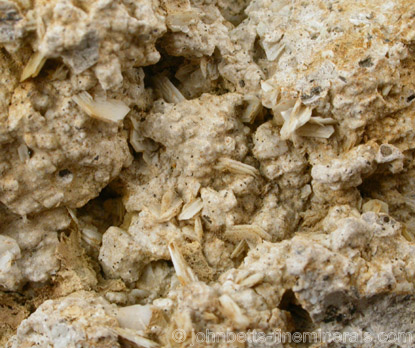The Mineral tridymite

Tridymite is a rare polymorph of the mineral Quartz. However, its crystals are very distinct and form very different habits from Quartz. Many Tridymite specimens are in fact pseudomorphs of Quartz after Tridymite, as the Tridymite often alters to the more common Quartz in many environments. After Quartz replaces the Tridymite, it still retains the original, distinct crystal form of Tridymite. True Tridymite and Quartz pseuomorphs are virtually indistinguishable without locality knowledge or x-ray analysis.
The name "Tridymite" was derived from its most common crystal habit as pseudohexagonal trillings.
Properties
Streak
White |
Hardness
7 |
Transparency
Transparent to translucent |
Specific Gravity
2.3 |
Luster
Vitreous |
Cleavage
Indiscernible |
Fracture
Conchoidal |
Tenacity
Brittle |
Crystal Habits
Although Tridymite crystallizes in the triclinic system, it is always a pseudomorph. It will either be a pseudomorph after Beta Tridymite, which crystallizes in the hexagonal system, or a pseudomorph of Quartz, which also crystallizes in the hexagonal system. Thus Tridymite occurs in hexagonally shaped crystals.
Click here for a detailed explanation on the crystal structure of Tridymite and other forms of silica.
Crystals are usually small, and appear as thin tabular plates. They commonly form intergrowths of two or three thin individuals, forming unusual and distinctive twins or trillings. Tridymite also occurs as small grains and as complex icicle-like formations.
Uses
Tridymite is a valuable mineral to collectors. Specimens of this rare and distinctive mineral provide interest to hobbyists. Tridymite is also used in scientific study. Its crystals provide key information to how crystals form, and how they change over in different environments. Tridymite is also synthetically produced for the production of refractory ceramics.
Noteworthy Localities
Some of the finest examples are from the Euganean Hills (Zovon and San Pietro in Montagna), Italy. Upon analysis, crystals from these localities were determined to be Quartz pseudomorphs after Tridymite. Other localities include Lyttleton Harbor, New Zealand; Dinas Head, Padstow, Cornwall, England; Vechec, Northern Slanske Mountains, Slovakia; and Cerro San Cristobal, Pachua, Mexico.
In the U.S., Tridymite occurs in the Thomas Range, Juab Co., Utah; Beidel Creek, in the San Juan Mountains in Colorado; Obsidian Cliff in Yellowstone National Park, Wyoming; Highway 78 roadcut, Big Lue Mountains, Greenlee Co., Arizona; and Mt. Lassen in Lassen Volcanic National Park, California.
Distingushing Similar Minerals
The unusual crystals and mode of occurrence distinguish Tridymite from all other minerals.